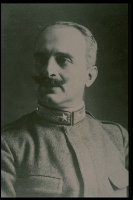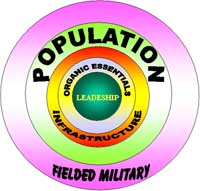Giulio Douhet, John “Jack” Slessor, and John Warden
Sep 18, 1947 Airforce Birthday
Wed 19 September 2001 (0830- 1130)
Dr. Clay Chun 245-3294
LESSON 20:THEORY OF WAR III: AIR POWER THEORIES
Introduction.
a. Technological advances have allowed man to wage warfare in the air, and in the future perhaps space. One could arguably trace aerial warfare back to the 1700's with the advent of balloons and suggestions to use them to reconnoiter enemy positions and potentially bomb them. Military aviation has evolved from the first use of aircraft in Italy's invasion of Libya in 1911, the first massive use of aviation in World War I, extensive tactical and strategic air power applications in World War II, the wide spread use of air power from counter insurgencies to nuclear deterrence during the Cold War, and finally to the demonstration of air power in the Persian Gulf War and Kosovo. Some may argue that air power can conduct operations that can independently solve military and political crises. Others believe that air power's real value lies in its ability to support surface operations. How does one resolve such contradictory positions? Each position has a bit of truth. On one hand, air power could deliver a nuclear strike and potentially destroy a nation-state. However, what happens in cases where a conflict involves non-state actors? Similarly, air power can significantly aid a war effort through the conduct of close air support for surface operations. Unfortunately, this option may constrain the potential use of air power to strike at the heart of an enemy's capabilities and reduce their ability to fight a war.
b. This lesson examines the writings and theories of three proponents of air power: Giulio Douhet, John “Jack” Slessor, and John Warden. We will discuss these divergent views of air power and explore their relevance. Each theory has potential impacts on force structure, planning, operations, and policy. Additionally, air power was born and nurtured by advances in technology. How did advances in technology transform the nature of air power?
 Required Readings. U.S. Army War College, Department of National Security and Strategy. Readings in War, National Security Policy, and Strategy. Carlisle Barracks: 2001. Vol. III: (Student Issue)
Required Readings. U.S. Army War College, Department of National Security and Strategy. Readings in War, National Security Policy, and Strategy. Carlisle Barracks: 2001. Vol. III: (Student Issue)
(1) Melinger, Phillip S. The Paths of Heaven: The Evolution of Airpower Theory. Maxwell Air Force Base, AL: Air University Press, 1997. “Giulio Douhet and the Origins of Airpower Theory,” Ch. 1, pp. 1-40.
(2) Melinger, Phillip S. The Paths of Heaven: The Evolution of Airpower Theory. Maxwell Air Force Base, AL: Air University Press, 1997. “Trenchard, Slessor, and Royal Air Force Doctrine before World War II,” Ch. 2, pp. 61-72.
(3) Warden, John A. III “The Enemy as a System,” Airpower Journal. (Spring 1995): 40-55. Scan it!
 Points to Consider.
Points to Consider.
 Assumption Assumption
- Offensive - Bomber - Battle planes - Independent air operations - Civil Morale Fragile Thesis
|
Giulio Douhet was born in Caserta, near Naples, on 30 My 1869. His father came from a long line of soldiers, and his mother was from a family of teachers and journalists. Giulio Douhet died of a heart attack on 15 February 1930.
- graduating first in the class at the Genoa Military Academy - artillery in 1888 - industry, - transportation infrastructure, - communication nodes, - government buildings, and - the will of the people. the most important |
 |
 |
Jack Slessor : A Different View
* Douhet as the quientessential supporter of strategic bombardment - air power can do it all. * Slessor looked at surface operations and air power. - Air complements ground - Air superiority - Multiple operations - Paralysis - Concurrent operations - Airmen in charge |
 |
Col John A Warden : The Enemy As A System
Five-Ring Model Bluf : A new way to identify the enemy centers of strategic and operational gravity Outline - Fielded Military
|
 |
Major General Billy Mitchell
- Seperate from the Army - Court martial |
 |